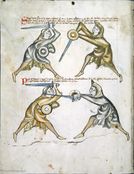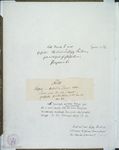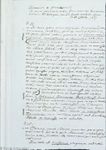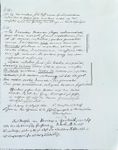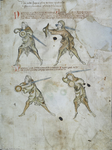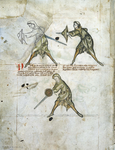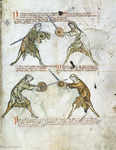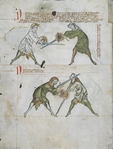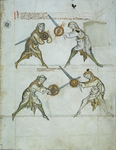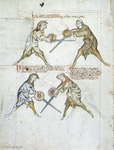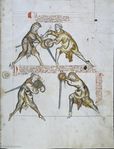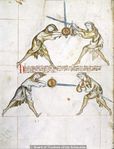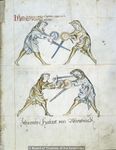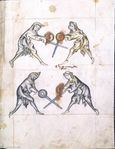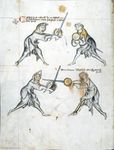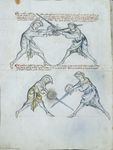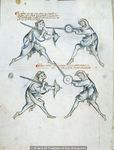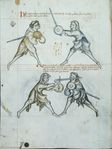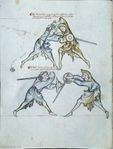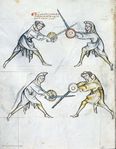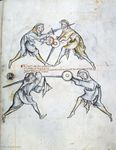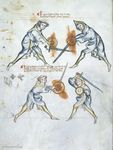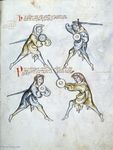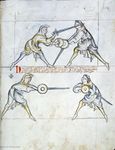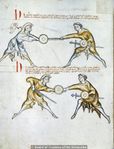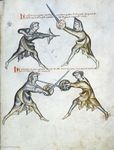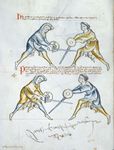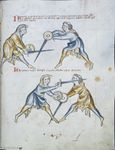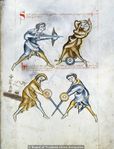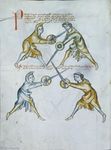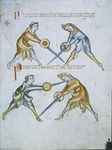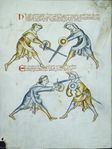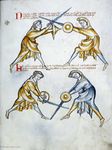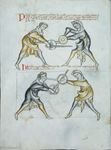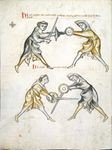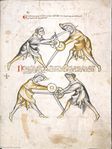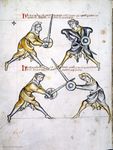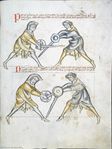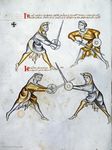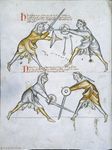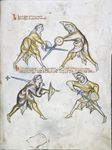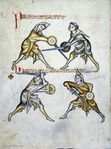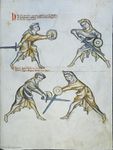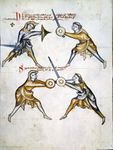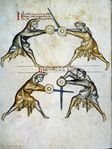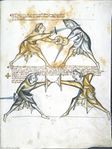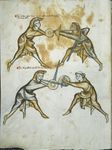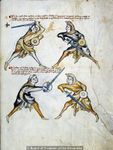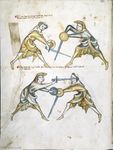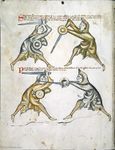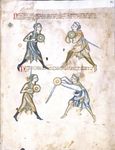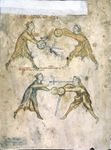|
|
You are not currently logged in. Are you accessing the unsecure (http) portal? Click here to switch to the secure portal. |
Difference between revisions of "Walpurgis Fechtbuch (MS I.33)"
| Line 80: | Line 80: | ||
== Gallery == | == Gallery == | ||
| + | |||
| + | {{collation}} | ||
These scans are licensed under the terms of the [https://royalarmouries.org/wp-content/uploads/2018/03/Non-Commercial-Licence.pdf Royal Armouries Non-Commercial Licence]. | These scans are licensed under the terms of the [https://royalarmouries.org/wp-content/uploads/2018/03/Non-Commercial-Licence.pdf Royal Armouries Non-Commercial Licence]. | ||
Revision as of 15:59, 5 February 2021
| Walpurgis Fechtbuch | |||||
|---|---|---|---|---|---|
| MS I.33, Royal Armouries Leeds, United Kingdom | |||||
| |||||
| |||||
| Also known as |
| ||||
| Type | Fencing manual | ||||
| Date | ca. 1320s | ||||
| Place of origin | Franconia | ||||
| Language(s) | Medieval Latin | ||||
| Ascribed to | Clericus Lutegerus | ||||
| Scribe(s) | Unknown (three hands) | ||||
| Illustrator(s) | Unknown (up to 17 artists) | ||||
| Material | Parchment, in a modern binding | ||||
| Size | 32 folia (300 mm x 230 mm) | ||||
| Format | Double-sided; two illustrations per side with text above and below | ||||
| Previously kept | MS Membr.I 115, Schloß Friedenstein | ||||
| Treatise scans |
Digital scans (600x800)
| ||||
The MS I.33 (recently re-cataloged as FECHT 1) is a German fencing manual dating to the 1320s.[1] It currently rests in the holdings of the Royal Armouries at Leeds, United Kingdom. It contains oldest extant treatise on Medieval martial arts, Liber de Arte Dimicatoria, and it appears to have been devised by a secular priest, possibly the "Lutegerus" (Ludger) mentioned in the text.[2] It was the work of three scribes and potentially as many as 17 illustrators.[3] The manuscript in its present form consists of five quires, of which all but the first are incomplete; at least eight leaves are believed to be missing (assuming it started with complete quires of four bifolia each).[3]
Contents
Provenance
The known provenance of the MS I.33 is:
- Written in the 1320s, possibly by a priest named Ludger; owned by Franconian monks until the 1500s.
- 1400s – an additional couplet was inscribed at the top of folio 1r, apparently a quotation from Enea Silvio Bartolomeo Piccolomini (Pope Pius II).
- 1552-53 – looted from a monastery by Johannes Herbart von Würzburg during the Franconian campaigns of Albrecht II, margrave of Brandenburg-Kulmbach.[4][3] Würzburg was a belt-maker by trade and later served as fencing master to the dukes of Sachsen-Gotha; he inscribed his name on folio 7r.
- before 1579 – possibly duplicated by Heinrich von Gunterrodt while compiling material for his book[4] (such a copy is currently unknown).
- late 1500s-1945 – owned by the dukes of Sachsen-Gotha; listed in an 18th century library catalog as Cod.Membr.I.no.115.[citation needed] The second device on folio 26r was copied into the Codex Guelf 125.16 Extravagante in the 1600s by a scribe who couldn't decipher the Latin text.[5] The manuscript was further described on six leaves of paper (with short excerpts of the text) by Heinrich Niewöhner in 1910. (Lost during World War II.)
- 1945-1950 – location unknown (sold London, Sotheby's, 27 March 1950). Sotheby's listed the manuscript as "a 14th-century manuscript of unknown provenance", and it was not identified as the lost Cod.Membr.I.no.115. until Krämer in 1975.[6]
- 1950-1996 – held by the Royal Armouries and stored in the Tower of London; known variously as "Tower of London Ms. I.33" or "British Museum No. 14 E iii, No. 20, D. vi. I".
- 1996 – moved to the newly-opened Royal Armouries Museum in Leeds.
Contents
| Irv | Front matter |
|---|---|
| 1r - 32v | Sword and buckler, possibly by Clericus Lutegerus |
Gallery
These scans are licensed under the terms of the Royal Armouries Non-Commercial Licence.
Folia 1r-3v have been conceptually restored by artist Mariana López Rodríguez; unmodified versions can be viewed on the Royal Armouries website.
Additional Resources
- Binard, Fanny and Jaquet, Daniel. "Investigation on the collation of the first Fight book (Leeds, Royal Armouries, Ms I.33)". Acta Periodica Duellatorum 4(1): 3-21. 2016. doi:10.1515/apd-2016-0001.
- Cinato, Franck and Surprenant, André (in French). Le Livre de l'art du Combat: Liber de arte dimicatoria. Édition critique du Royal Armouries MS. I.33, collection Sources d'Histoire Médiévale nº39. Paris: CNRS Editions, 2009. ISBN 978-2-271-06757-9
- Dawson, Timothy. "The Walpurgis Fechtbuch: An Inheritance of Constantinople?" Arms & Armour 6(1):79-92. April 2009. doi:10.1179/174962609X417536
- Forgeng, Jeffrey L. The Illuminated Fightbook Royal Armouries Manuscript I.33. Extraordinary Editions, 2012.
- Forgeng, Jeffrey L. The Medieval Art of Swordsmanship: A Facsimile & Translation of Europe's Oldest Personal Combat Treatise, Royal Armouries MS I.33 (Royal Armouries Monograph). Chivalry Bookshelf, 2003. ISBN 1-891448-38-2
- Forgeng, Jeffrey L. The Medieval Art of Swordsmanship: Royal Armouries MS I.33. Royal Armouries, 2018. ISBN 978-0948092855
- Gräf, Julia. "Fighting in women’s clothes: The pictorial evidence of Walpurgis in Ms. I.33". Acta Periodica Duellatorum 5(2):47-71. December 2017. doi:10.1515/apd-2017-0008.
- Hester, James. "A Few Leaves Short of a Quire: Is the ‘Tower Fechtbuch’ Incomplete?" Arms & Armour 9(1):20-25. April 2012. doi:10.1179/1741612411Z.0000000003
- Hester, James. "Home-Grown Fighting: A Response to the Argument for a Byzantine Influence on MS I.33". Arms & Armour 9(1):76-84. April 2012. doi:10.1179/1741612411Z.0000000008
- Kellett, Rachel E. "Royal Armouries MS I.33: The Judicial Combat and the Art of Fencing in Thirteenth- and Fourteenth- Century German Literature". Oxford German Studies 41(1):32-56. April 2012. doi:10.1179/0078719112Z.0000000003
- Morini, Andrea and Rudilosso, Riccardo (in Italian). Manoscritto I.33. Rome: Il Cerchio Iniziative Editoriali, 2012.
References
- ↑ The manuscript has received a wide variety of dates. Anglo (1988) dated it to "the very end of the 13th century" and Hils (1985) to the early 14th century; Cinato and Surprenant (2009) are even less precise, placing it at around the turn of the 14th century. Most recent analysis has preferred the very late end of this range, with Leng (2008) dating it to 1320-1330 and Hester (2012) to "around 1320".
- ↑ See folio 1v.
- ↑ 3.0 3.1 3.2 Hester (2012).
- ↑ 4.0 4.1 von Gunterrodt, Heinrich. De Veris Principiis Artis Dimicatorie. Wittenberg, 1579. p C3rv
- ↑ See Codex Guelf 125.16.Extrav., f 45r.
- ↑ S. Krämer. "Verbleib unbekannt Angeblich verschollene und wiederaufgetauchte Handschriften." Zeitschrift für Deutsches Altertum und Deutsche Literatur, volume 104. 1975
Copyright and License Summary
For further information, including transcription and translation notes, see the discussion page.
| Work | Author(s) | Source | License |
|---|---|---|---|
| Images | Royal Armouries | Used under the Royal Armouries Non-Commercial Licence | |
| Transcription | Dieter Bachmann | Index:Walpurgis Fechtbuch (MS I.33) |

